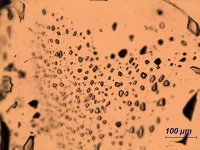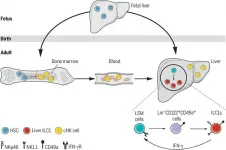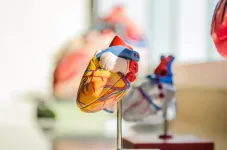Estimating lifetime microplastic exposure
2021-03-31
(Press-News.org) Every day, people are exposed to microplastics from food, water, beverages and air. But it's unclear just how many of these particles accumulate in the human body, and whether they pose health risks. Now, researchers reporting in ACS' Environmental Science & Technology have developed a lifetime microplastic exposure model that accounts for variable levels from different sources and in different populations. The new model indicates a lower average mass of microplastic accumulation than previous estimates.
Microplastics, which are tiny pieces of plastic ranging in size from 1 μm to 5 mm (about the width of a pencil eraser), are ingested from a variety of sources, such as bottled water, salt and seafood. Their fate and transport in the human body are largely unknown, although the particles have been detected in human stool. In addition to possibly causing tissue damage and inflammation, microplastics could be a source of carcinogens and other harmful compounds that leach from plastic into the body. Previous studies have tried to estimate human exposure to the particles and their leached chemicals, but they have limitations, including discrepancies in the databases used, a failure to consider the entire microplastic size range and the use of average exposure rates that do not reflect global intakes. Nur Hazimah Mohamed Nor, Albert Koelmans and colleagues wanted to develop a comprehensive model to estimate the lifetime exposure of adults and children to microplastics and their associated chemicals.
To make their model, the researchers identified 134 studies that reported microplastic concentrations in fish, mollusks, crustaceans, tap or bottled water, beer, milk, salt and air. They performed corrections to the data so that they could be accurately compared among the different studies. Then, the team used data on food consumption in different countries for various age groups to estimate ranges of microplastic ingestion. This information, combined with rates of microplastic absorption from the gastrointestinal tract and excretion by the liver, was used to estimate microplastic distribution in the gut and tissues. The model predicted that, by the age of 18, children could accumulate an average of 8,300 particles (6.4 ng) of microplastics in their tissues, whereas by the age of 70, adults could accrue an average of 50,100 microplastic particles (40.7 ng). The estimated amounts of four chemicals leaching from the plastics were small compared with a person's total intake of these compounds, the researchers concluded. These data suggest that prior studies might have overestimated microplastic exposure and possible health risks, but it will be important to assess the contributions of other food types to ingestion and accumulation, the researchers say.
INFORMATION:
The authors acknowledge funding from Yayasan Mendaki, the Prophet Muhammad's Birthday Memorial Scholarship Fund Board and the Aquatic Ecology and Water Quality group of Wageningen University and Research.
The paper is freely available as an ACS AuthorChoice article here.
For more of the latest research news, register for our upcoming meeting, ACS Spring 2021. Journalists and public information officers are encouraged to apply for complimentary press registration by emailing us at newsroom@acs.org.
The American Chemical Society (ACS) is a nonprofit organization chartered by the U.S. Congress. ACS' mission is to advance the broader chemistry enterprise and its practitioners for the benefit of Earth and all its people. The Society is a global leader in promoting excellence in science education and providing access to chemistry-related information and research through its multiple research solutions, peer-reviewed journals, scientific conferences, eBooks and weekly news periodical Chemical & Engineering News. ACS journals are among the most cited, most trusted and most read within the scientific literature; however, ACS itself does not conduct chemical research. As a specialist in scientific information solutions (including SciFinder® and STN®), its CAS division powers global research, discovery and innovation. ACS' main offices are in Washington, D.C., and Columbus, Ohio.
To automatically receive news releases from the American Chemical Society, contact newsroom@acs.org.
Follow us: Twitter | Facebook
ELSE PRESS RELEASES FROM THIS DATE:
2021-03-31
In Brazil, researchers are puzzling over socioeconomic and environmental indicators that do not add up. They are concerned with what they call the São Paulo Macrometropolitan Area, a mega-region comprising five metropolitan areas in the state of São Paulo with a total of 180 municipalities, some of which provide ecosystem services while others receive them. The problem is that the former, which provide the others with water, food and power generation inputs, suffer from steep inequities in terms of defective human development and lack of social inclusion.
"Urban centers have always been ...
2021-03-31
Glass, rubber and plastics all belong to a class of matter called amorphous solids. And in spite of how common they are in our everyday lives, amorphous solids have long posed a challenge to scientists.
Since the 1910s, scientists have been able to map in 3D the atomic structures of crystals, the other major class of solids, which has led to myriad advances in physics, chemistry, biology, materials science, geology, nanoscience, drug discovery and more. But because amorphous solids aren't assembled in rigid, repetitive atomic structures like crystals are, they have defied researchers' ability to determine their atomic structure with the same level of precision.
Until now, that is. ...
2021-03-31
Sugar practically screams from the shelves of your grocery store, especially those products marketed to kids.
Children are the highest consumers of added sugar, even as high-sugar diets have been linked to health effects like obesity and heart disease and even impaired memory function.
However, less is known about how high sugar consumption during childhood affects the development of the brain, specifically a region known to be critically important for learning and memory called the hippocampus.
New research led by a University of Georgia faculty member in collaboration with a University ...
2021-03-31
LAWRENCE, KANSAS -- The phrase "to see red" means to become angry. But for investors, seeing red takes on a whole different meaning.
William BazleyThat's the premise behind a new article by William Bazley, assistant professor of finance at the University of Kansas.
"Visual Finance: The Pervasive Effects of Red on Investor Behavior" reveals that using the color red to represent financial data influences individuals' risk preferences, expectations of future stock returns and trading decisions. The effects are not present in people who are colorblind, and they're muted in China, where red represents prosperity. Other colors do not generate the same outcomes.
The ...
2021-03-31
As demand for low-carbon electricity rises around the world, nuclear power offers a promising solution. But how many countries are good candidates for nuclear energy development?
A new study in the journal Risk Analysis suggests that countries representing more than 80 percent of potential growth in low-carbon electricity demand--in Asia, the Middle East, and North Africa--may lack the economic or institutional quality to deploy nuclear power to meet their energy needs. The authors suggest that if nuclear power is to safely expand its role in mitigating climate change, countries need to radically improve their ability to manage the technology.
"Efforts to enhance institutional quality in these countries must be redoubled and could well be one of the ...
2021-03-31
Taking progestogens - steroid hormones - during pregnancy could reduce the risk of preterm birth in high-risk single baby pregnancies, research has shown.
Although these compounds have been in use for some time, results of individual clinical trials investigating their effectiveness in preventing preterm birth have been conflicting, and so further evaluation of the research evidence was needed.
University of York researchers led the Evaluating Progestogens for Prevention of Preterm Birth International Collaborative (EPPPIC) project, a systematic review which brought together and re-analysed datasets from 31 clinical trials of progestogens, including more than 11,000 women and 16,000 babies ...
2021-03-31
Microbial life already had the necessary conditions to exist on our planet 3.5 billion years ago. This was the conclusion reached by a research team after studying microscopic fluid inclusions in barium sulfate (barite) from the Dresser Mine in Marble Bar, Australia. In their publication "Ingredients for microbial life preserved in 3.5-billion-year-old fluid inclusions," the researchers suggest that organic carbon compounds which could serve as nutrients for microbial life already existed at this time. The study by first author Helge Mißbach (University of Göttingen, Germany) was published in the journal ...
2021-03-31
Researchers from the University of Science and Technology of China (USTC) of the Chinese Academy of Science (CAS), teamed up with scientists from Aix Marseille University, discovered that hematopoietic progenitors possessed the differentiation potential to type 1 innate lymphoid cells (ILC1s) in adult liver, and dissected the regulation mechanisms of such cell differentiation, revealing the pathways that lead to the development of tissue-resident lymphocytes. This study was published in Science.
Hematopoiesis occurs at different sites following the development of human body. After birth, the bone marrow (BM) has long been known to be the main hematopoietic organ ...
2021-03-31
ST segment-elevation myocardial infarction (STEMI) is a particularly severe type of heart attack associated with a high risk of mortality or long-term disability. Clinicians can reduce a patient's chances of unfavorable outcomes by performing a procedure known as percutaneous coronary intervention (PCI), which combines coronary angioplasty--in which a balloon is inserted into a blocked artery of the heart to clear it--with stenting--inserting a tiny tube into a blocked artery to keep the line open. But studies in China have found that many patients with STEMI choose not to undergo PCI and that women with STEMI, in particular, have a reduced likelihood of undergoing guideline-based ...
2021-03-31
By harvesting energy from their surrounding environments, particles named 'artificial micromotors' can propel themselves in specific directions when placed in aqueous solutions. In current research, a popular choice of micromotor is the spherical 'Janus particle' - featuring two distinct sides with different physical properties. Until now, however, few studies have explored how these particles interact with other objects in their surrounding microenvironments. In an experiment detailed in EPJ E, researchers in Germany and The Netherlands, led by Larysa Baraban at Helmholtz-Zentrum Dresden-Rossendorf, show for the first time how the velocities of Janus particles relate to the physical properties of nearby barriers.
The team's discoveries could help researchers to engineer micromotors which ...
LAST 30 PRESS RELEASES:
[Press-News.org] Estimating lifetime microplastic exposure




